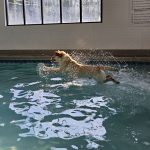MANAGING THE SYMPTOMS OF CANINE OSTEOARTHRITIS
Did you know, according to the Arthritis Foundation, one in five dogs suffer from osteoarthritis? This disease is more commonly found in older dogs, and tends to be more prominent with larger breeds.
Unfortunately, this debilitating disease has no cure. However, if you are quick in identifying the problem, with proper treatment and management, you may be able to keep your pup active, thereby improving his quality of life.
What is Canine Osteoarthritis?
Canine Osteoarthritis is the progressive deterioration of joint cartilage and is often referred to as Degenerative Joint Disease (DJD). As the joints deteriorate, inflammation worsens.
As the cushion, or joint breaks down, movement is impaired. This can occur due to age, disease, injury, weight issues, or repeated stress on the joint.
Losing this cushion can cause the dog much pain, inflammation and range of movement issues. Bone spurs can also develop, as a result, of joint issues.
In dogs, this disease is commonly found in the spine and/or limbs.
Risk Factors
Although any dog can develop arthritis, some dogs may have more of a predisposition to this disease:
- Obese dogs
- Infections, such as Lyme Disease
- Larger breeds
- Poor nutrition
- Genetics
- Prior dysplasia
- Injuries
- Repeated stress (ongoing activities that cause stress on the joints)
If your pup has a majority of these risk factors, it is important to keep up with their annual visits to your veterinarian.
Symptoms of Arthritis in Dogs
Sadly, the early stages of osteoarthritis are not always visible. As pet owners, we know that pets will often “hide” symptoms of feeling unwell and/or pain.
The more common signs that your dog may be suffering from the effects of arthritis include, but are not limited to the following:
- Limping
- Stiffness
- Trouble getting up
- Changes in behavior
- Yelping when getting picked up and/or touched
- Unwillingness to jump
- Posture issues
- Changes in urination/defecation (more and more accidents inside the home and/or the way in which they do these normal functions)
As mentioned above, if you find that your pet (especially an older pet) is exhibiting these signs, contact your veterinarian. Through physical examination, your doctor will evaluate him given a series of range of motion tests. X-rays and bloodwork may also be recommended to confirm the arthritis diagnosis and/or to rule out other possible issues.
Treatment of Canine Osteoarthritis
Given this progressive disease has no cure, treatment tends to focus on controlling pain by reducing inflammation to improve the quality of your pup’s life and well-being.
Upon evaluation and diagnosis, your veterinarian will develop a treatment plan specific to your dog.
Most treatments will include a variety of therapies in combination to achieve the proper and best outcome for your pet:
- Physical therapy
- Joint supplements
- Diet changes
- Weight management
- NSAIDs (not the human kind)
- Homeopathic treatments (acupuncture, laser, CBD)
- Possible surgery (joint replacement, ACL sugery)
How we can help at Independence Veterinary Clinic
If you are local to the Charlotte, North Carolina region, we have a team dedicated to improving your pup’s quality of life through physical therapy and rehabilitation.
For everything you need to know about Healing Pups and our incredible staff led by Dr. Kefer, click here. Also, be sure to check out our Healing Pups blog post!











